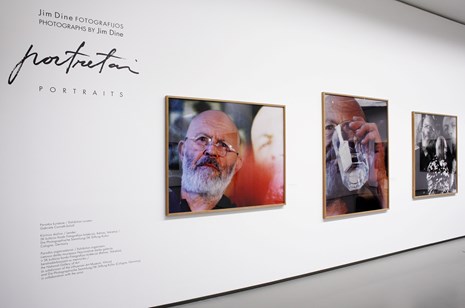Portraits. Photographs by Jim Dine

Portraits. Photographs by Jim Dine
The exhibition features more than thirty of the most important photographic portraits by the artist Jim Dine. The large-format works were produced between 2002 and 2007 and exemplify the broad palette with which he deals with the genre in an eclectic sense.
The artist, born in 1935 in Cincinnati, Ohio, became well known in the 1960s as one of the main exponents of Pop Art. Yet he soon no longer identified himself with this art movement, for-far from an objective world of commodities and quick sales-poetry, art history, emotional values, and artisanal aspects gained an increasingly important role in his creative work. For Dine, the fact that he can now present his works in Vilnius is a unique opportunity, as his ancestral roots are in Lithuania-it is the country of birth of both of his paternal grandparents, who immigrated to the United States in the 19th century.
For Jim Dine, photography is an artistic medium that he discovered relatively late in his career. While he may have used photos for his collages and assemblages as early as in the 1960s, illustrating a volume by the poet Guillaume Apollinaire with his own photographs in 1968, photography has acquired substantial importance within his oeuvre since the mid-1990s.
Those close to Jim Dine-be they real human beings or artificial figures he has created-to whom he devotes his portraits, can without exception be regarded as loyal companions and, above all, inexhaustible sources of inspiration. To begin with, mention can be made of his companion and soul mate, the artist and photographer Diana Michener, who often serves as a model for his richly varied visual perception, but also longtime friends, members of his family, and related artists such as Robert Creeley or Mary McCarthy. At the same time, it should be mentioned that several of the people included in Dine's photographic "notebook" have already died, yet they are nevertheless acutely present in his current cosmos of images. The artist bridges the impossibility of their being personally present before the camera by, for example, citing anonymous, casual photographs or pieces of writing, which he adopts as his own in the photographic process by means of their repeated treatment. In doing so, different layers of reality and time are collaged together in a photograph and give rise to a new image.
If one looks at the figures that have developed out of Dine's range of artistic works, one encounters, for instance, Pinocchio puppets full of character that the artist has collected who are occasionally accompanied on their imaginary adventures by a porcelain ape and a porcelain rooster, or a proudly sublime raven. One also comes upon striking, unusual portrait studies of Pinocchio that, like those of his adversary, the sly fox, can be traced back to sculptures Jim Dine created in wood. There is also the picture of a pair of wooden puppets that again demonstrates how successful Dine is in causing things to speak and evoking associations.
The portraits by Jim Dine lead us into a realm, nearly vaster than the eye can take in, of interconnected energies, views of reality, and illusions in which the boundaries between reality and fiction, between art and life, are fluid.
The images on exhibition are based on the application of traditional photographic methods with negative material and conventionally performed enlargements. The black-and-white photographs are silver gelatin prints, and the color images are chromogenic color prints.
Exhibition curator: Gabriele Conrath-Scholl Director of Die Photographische Sammlung/SK Stiftung Kultur, Cologne, Germany


